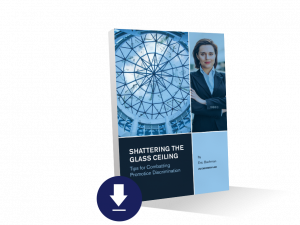“Orchestrating impartiality:” blind auditions and cracking the glass ceiling in symphonies
“I just don’t think women should be in an orchestra.” This candidly biased statement by an orchestra conductor who was prominent in the 1960’s and 1970’s sums up the barriers then faced by aspiring female musicians:
- In the 1970’s, unless you were a white male musician you had almost no chance of being hired by one of the major orchestra symphonies in the United States;
- The male musical director usually handpicked the musicians from a group of male students who studied under select male teachers;
- Indeed, about 95% of the positions in these orchestras were held by white men.
While most people associate the term “glass ceiling” with artificial barriers that prevent women from advancing to upper-level management positions, glass ceilings also exist for racial minorities, the LGBT community, and other protected groups.
Indeed, along with the openly expressed as well as unspoken biases female musicians faced, rampant race discrimination also existed in the orchestra hiring process, as illustrated by an important discrimination case against the New York Philharmonic symphony in the 1960’s, as reported by the New York Times.
What is a blind audition and what does it have to do with glass ceiling discrimination?
To combat the glass ceiling of biased views and assumptions about who should and should not be in an orchestra, starting in the 1970’s and 1980’s several orchestra hiring groups experimented with using “blind” auditions for musicians. In a blind audition, the musicians perform behind a screen and use other measures—taking high heel shoes off to mute their distinctive clicking sound—to help conceal the gender and race of the performer.
This puts the focus on the candidates’ abilities as opposed to evaluating whether the candidates fit the evaluators’ explicit or implicit biases about who should be in an orchestra. In a groundbreaking study called “Orchestrating Impartiality,” authors Claudia Golden and Cecilia Rouse evaluated the impact of blind auditions in symphony orchestra auditions. Using statistical analyses, they determined that the blind audition process significantly benefited female musicians and made it more likely that they would pass the initial selection rounds and ultimately be hired.
Since the institution of these blind auditions, the percentage of women employed by the major symphony orchestras increased to about 35% by the mid-2000’s.
From symphony orchestras to “The Voice” to the business world
The hiring progress made in world-class symphony orchestras is encouraging, but can it be replicated in the business world? It’s an important question because, notwithstanding the substantial ground gained in the top orchestra symphonies, the U.S. still ranks 20th out of 29 surveyed countries in The Glass Ceiling Index for equal treatment of women in the work place (according to a study by the Organization for Economic Cooperation and Development recently published in the Economist).
One new setting in which blind auditions have flourished is “The Voice” television show. On the show, celebrity judges turn their backs to contestants so that the judge’s attention and vote will be focused on singing ability above all else.
Following in the footsteps of symphony orchestras and “The Voice,” businesses are now trying to institute blind auditions, or at least elements of a blind audition, into their hiring procedures. And companies like Gap Jumpers have begun marketing blind auditions for companies as a way to scale up the blind audition practices from the symphony stage to the corporate boardroom.
How blind auditions may help break the glass ceiling in corporate settings
The motivation for blind auditions in corporate hiring is to neutralize any unconscious (as well as intentional) bias that the hiring team may possess by removing the gender, race, national origin, etc. characteristics of the applicants. This way the focus should remain on the merits of the candidate’s “audition.” A company that is looking to hire candidates can work with a company like Gap Jumpers who will help them create a blind audition process. The process includes:
- Creating a series of job-related questions or tasks/challenges for candidates to answer;
- After the employer selects the questions the candidates anonymously answer them online;
- The answers are also timed to assess time management and diligence of the candidate;
- Likewise, protocols are in place to guard against candidates using plagiarized answers; and
- The anonymous answers are then reviewed and ranked using algorithms and human subject matter experts.
The goal of this process is to emphasize and assess how well the candidate responds to the “audition,” as opposed to simply collecting mountains of resumes.
Is it working?
A large sample size of employers who have used Gap Jumper’s blind audition hiring process, which began in 2014, is not available publicly. Some data, however, is available (based on over 1,000 auditions) that suggests the potential benefits of this approach. According to Gap Jumper:
- despite a perception that the lack of women in technology companies may be due to lack of skills, women make up almost 60% of the top performers in blind auditions; and
- another perception is that the dearth of women in technology companies is due to their low application numbers, but women are taking blind auditions at a rate (54%) comparable to their representation in the U.S. general population.
Food for thought: where blind auditions and employment discrimination may still intersect
Using some type of “blind audition” to help chip away at the corporate glass ceiling is intriguing, has common sense appeal, and deserves further development and serious study. One factor to consider, however, is whether using test questions—even those designed to anonymize the hiring process and level the playing field—may still run afoul of employment discrimination laws.
For example, Title VII of the 1964 Civil Rights Act outlaws intentional discrimination based on gender, race, national origin, and other protected characteristics during the hiring process. But it also prohibits using hiring practices that are neutral on their face (such as written tests), which have a discriminatory outcome: disproportionately excluding female, African-American, and other protected classes of applicants.
Employment tests and disparate impact discrimination
Even if the employer did not intend for an employment test to exclude these protected groups, if the test ultimately has the effect of rejecting an excessive number of otherwise qualified, for example, female or African-American applicants, then using the test might violate Title VII.
The employer, however, may still use the test—despite its discriminatory impact—if it can show that (1) the test is job-related and consistent with business-necessity (for example, the test is associated with the skills needed to perform the job), and (2) no less-discriminatory alternative test is feasible.
Employment tests, when used properly, may be legitimate and helpful tools to help identify qualified job candidates. But too often employers place an unjustified reliance/expectation on these tests; namely, that doing well on the test will translate into doing well on the job.
- For certain types of test, this may well be true. Take the common (albeit antiquated) example of using a typing test to select typists. This type of test is more likely to identify qualified typists based on how quickly and accurately they perform in the typing test.
- On the other hand, in Griggs v. Duke Power Co., the Supreme Court ruled that a written “intelligence test” administered to employees in a coal handling or maintenance department was unlawful because the test bore no discernable relationship to successful performance of the job.
- Likewise, the company had not conducted any meaningful study to see if the test correlated with job performance ability.
The key takeaway is that, without evidence that doing well on the test is predictive of success on the job, the test results may be irrelevant (best case), or have an unlawful discriminatory effect (worst case).
The stubborn endurance of corporate glass ceiling discrimination and what to do if you run into it
Women and racial minorities have made undeniable progress in the United States workforce and are gaining a larger share of management positions. Using blind auditions and other innovative hiring practices that may help to further breach the glass ceiling is an encouraging development for addressing the bars to advancement that exist.
But much work remains to be done to remove those barriers, particularly for the most-powerful and best-paying jobs. If you believe glass ceiling discrimination is currently blocking your career path, it is important to know your rights and to speak with an experienced attorney to help advise you about your legal options.










